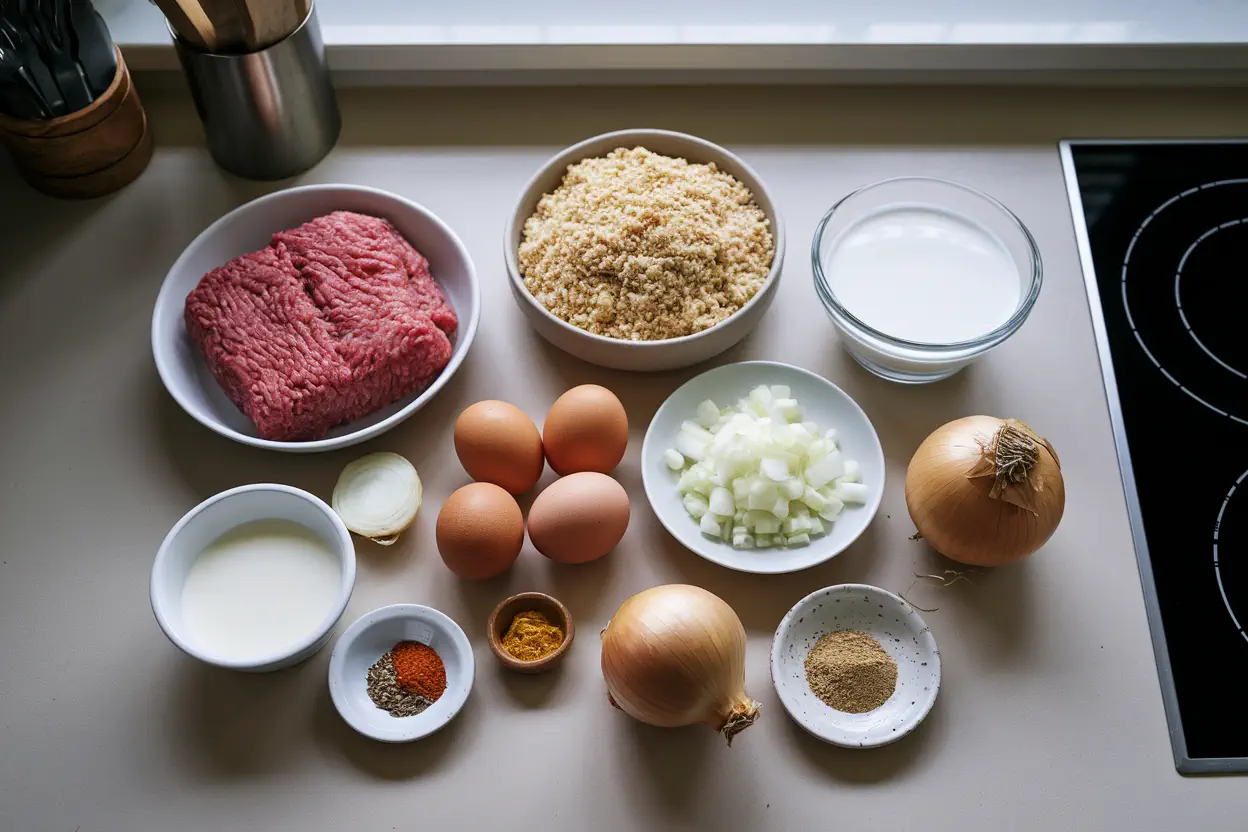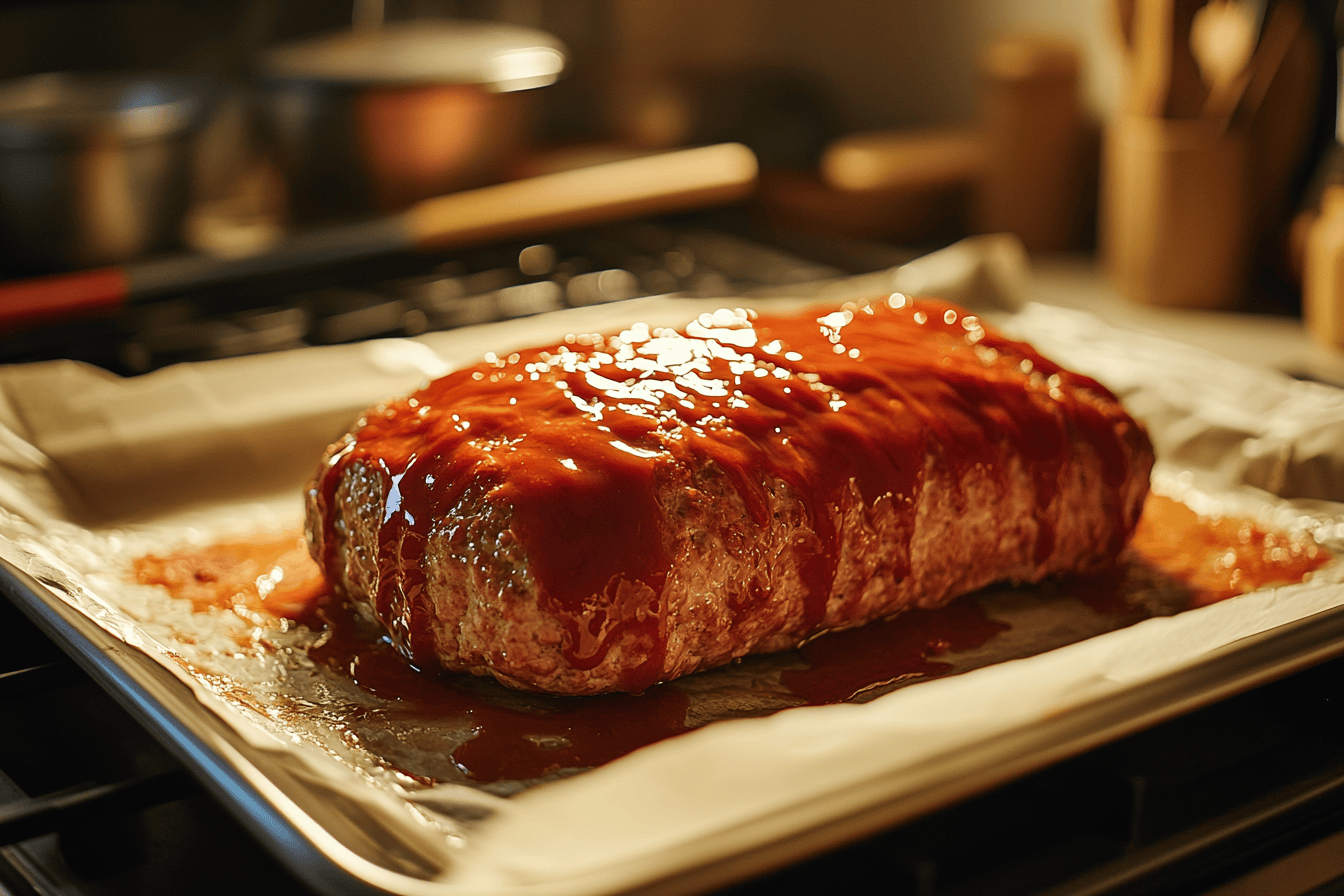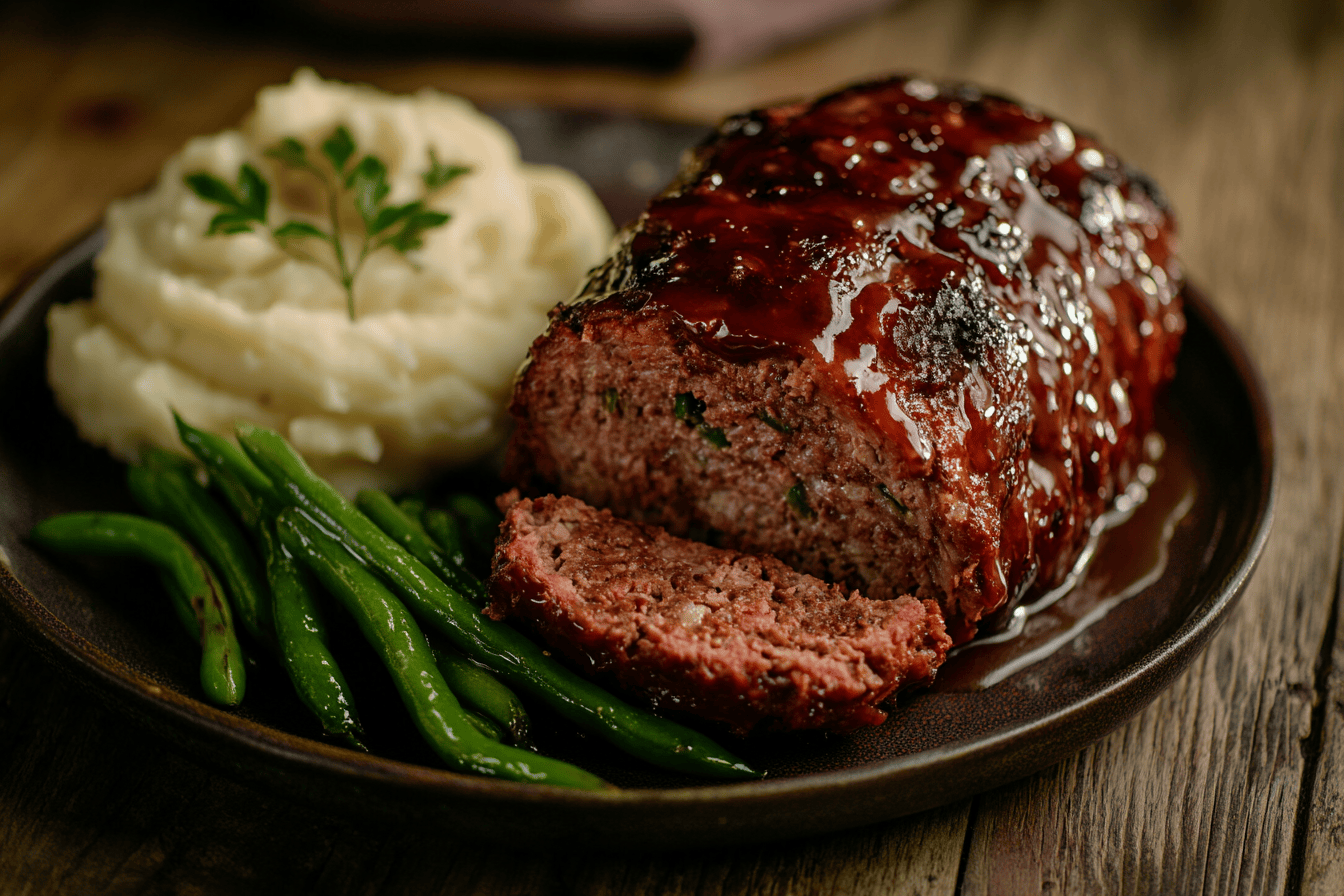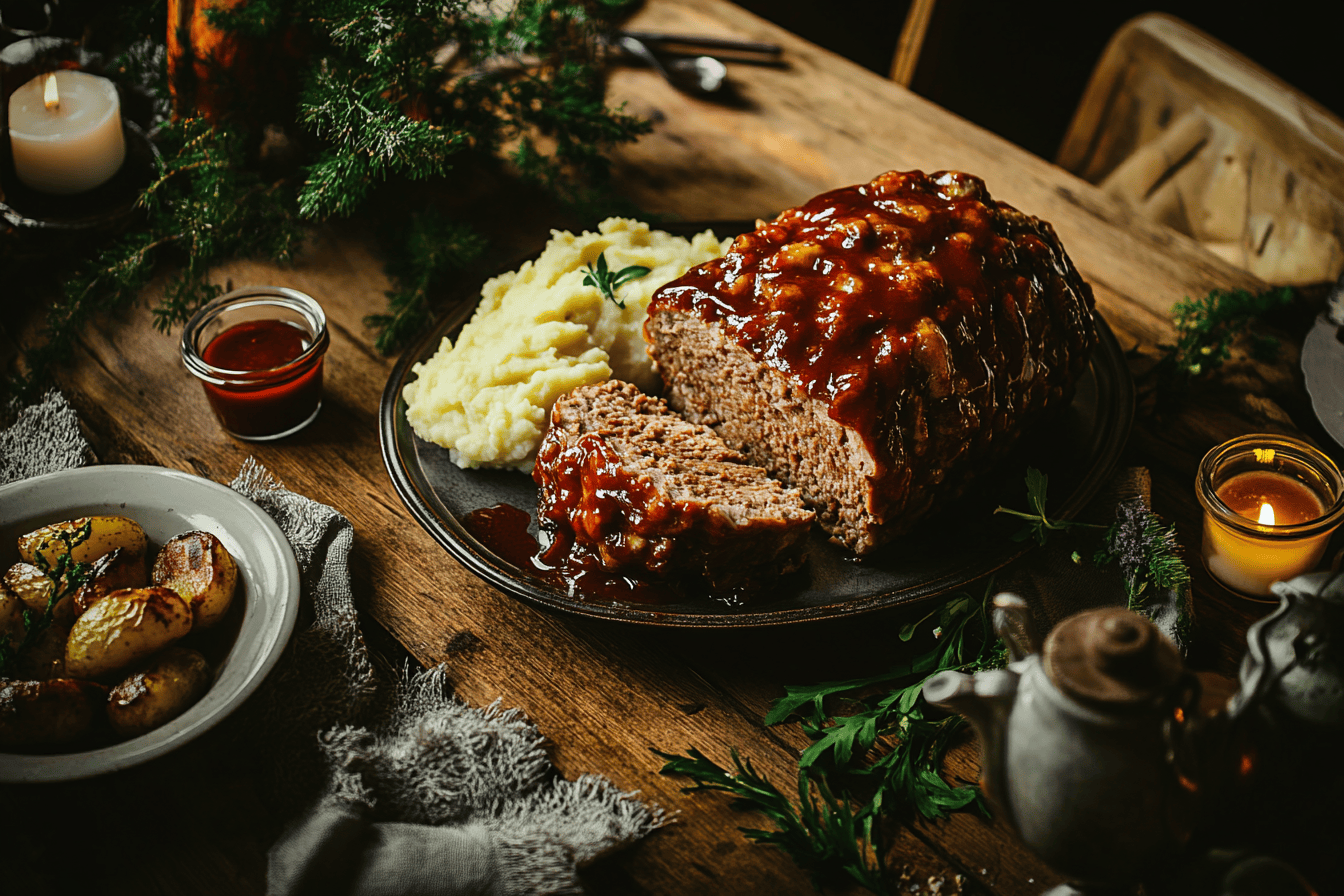If you’ve ever asked yourself, what is the basic meatloaf formula, you’re not alone. This iconic dish has been a staple of home cooking for decades, offering comfort and flavor in every bite. The formula is simple yet versatile: a perfect balance of protein, binder, and moisture. By mastering what is the basic meatloaf formula, you’ll have the foundation to create a dish that’s moist, flavorful, and adaptable to your taste. Whether you’re new to cooking or looking to perfect your skills, this guide will answer all your questions.
Table of Meatloaf Contents
Introduction to Meatloaf and its Popularity
What Makes Meatloaf a Comfort Food?
Meatloaf resonates with families worldwide because of its homestyle appeal and nostalgic value. It’s that dish many of us grew up with, often served with mashed potatoes and gravy. The beauty of homemade meatloaf lies in its simplicity—taking pantry staples and transforming them into a satisfying meal. Plus, its versatility means you can tweak the recipe to suit your taste buds or dietary needs.
Interestingly, meatloaf isn’t just a quick weeknight meal; it’s a symbol of warmth and togetherness. Few dishes evoke the same kind of cozy, hearty vibe that a perfectly baked loaf does, with its crispy edges and tender, flavorful center.
A Brief History of Meatloaf Across Cultures
Did you know that classic meatloaf recipes date back to ancient times? The concept of mixing minced meat with other ingredients stretches as far back as Roman times, when cooked meat was bound with bread and wine. In the Middle Ages, similar dishes were served as terrines or pâtés.
In America, the modern version took shape during the Great Depression. Ground beef became a staple, and families stretched their protein by mixing it with breadcrumbs, oats, and whatever ingredients were at hand. This frugal but ingenious formula laid the foundation for the traditional meatloaf we know and love today.
The Essential Ingredients for a Basic Meatloaf

The Core of Meatloaf: Protein Choices
The secret to a great meatloaf lies in knowing what is the basic meatloaf formula. Ground meat forms the foundation, while eggs, breadcrumbs, and milk act as the binders and moisture agents. Following this formula ensures your meatloaf holds its shape while staying tender and juicy.
For additional tips on enhancing your meatloaf’s flavor, check out how Lipton onion soup mix can elevate your recipe.
Binding Agents: Eggs and Breadcrumbs
The key to a sturdy but tender meatloaf lies in the binding agents. Eggs provide structure, while breadcrumbs hold everything together, absorbing moisture and preventing the loaf from falling apart. For a 2-pound meatloaf, the basic formula calls for 2 eggs and 1 cup of breadcrumbs. Want a twist? Use oats, crushed crackers, or panko for unique textures.
Flavor Boosters: Spices, Herbs, and Aromatics
Plain meatloaf can be bland, so don’t skimp on spices and aromatics. Classic additions include onions, garlic, salt, and pepper. Fresh herbs like parsley or thyme add a burst of flavor, while Worcestershire sauce or mustard gives depth. For a sweeter profile, mix in a splash of ketchup or BBQ sauce.
The Role of Moisture Ingredients: Milk and Broth
Dry meatloaf is a dealbreaker. To ensure it stays juicy, mix in a small amount of milk, broth, or even grated vegetables like zucchini. The moisture binds with the breadcrumbs, creating that signature tender texture.
The Standard Meatloaf Formula: Ratios and Measurements
Protein-to-Binder Ratio for Perfect Texture
A classic meatloaf formula ensures the perfect ratio: about 1 pound of meat to ½ cup of binder (breadcrumbs, oats, or crackers). For every pound of meat, one egg is typically enough to hold the mixture together. This balance ensures a meatloaf that is neither too dense nor too crumbly.
Moisture Content: Striking the Right Balance
Adding just the right amount of moisture is crucial. As a rule of thumb, use ¼ cup of milk, broth, or ketchup for every pound of meat. Be careful not to overdo it, or you’ll end up with a soggy loaf. Conversely, skimping on moisture can make the loaf dry and tough.
Common Variations to the Formula
The beauty of meatloaf is its versatility. Some cooks swear by adding grated cheese or chopped veggies like bell peppers for extra flavor. Others prefer substituting breadcrumbs with crushed pretzels for a unique crunch. No matter the variation, the foundation of What is the basic meatloaf formula? remains the same—balancing protein, binders, and moisture for a delicious result.
For more tips on crafting a juicy meatloaf, explore these expert recommendations.
Step-by-Step Preparation Guide

Mixing and Forming the Loaf
Sticking to what is the basic meatloaf formula ensures consistent results every time you make this classic dish. When mixing your ingredients, focus on achieving the perfect balance between meat, binder, and moisture. Following this formula not only guarantees the right texture but also makes it easier to customize the recipe to your liking.
Once mixed, shape the meat into a loaf. You can form it directly on a baking sheet or place it in a loaf pan. If using a loaf pan, consider lining it with parchment paper for easier removal. For those looking for a twist, individual mini-loaves baked in a muffin tin are fun and perfect for portion control.
Choosing the Perfect Pan for Cooking
The type of pan you use can influence the texture of your meatloaf. A loaf pan is great for holding shape, but it can trap excess grease. A rimmed baking sheet offers better airflow, helping to achieve a crispier crust. If you want to get creative, try shaping your meatloaf freehand on parchment paper for a rustic, homestyle look.
For more meatloaf tips, check out how to achieve the perfect crust with Lipton onion soup mix.
Baking Times and Temperature Guidelines
Preheat your oven to 350°F (175°C), a temperature ideal for even cooking. Bake your loaf for 50–60 minutes, or until the internal temperature reaches 160°F (71°C). Always use a meat thermometer to avoid undercooking. If adding a glaze, apply it during the last 15 minutes of baking for a sticky, caramelized finish.
Tips for a Golden-Brown Finish
A meatloaf’s crust is the star of the show. To achieve that golden-brown finish, brush the loaf with a mixture of ketchup, mustard, or BBQ sauce before baking. For an extra-crispy texture, broil the loaf for 2–3 minutes once fully cooked. Just keep a close eye on it to prevent burning.
Secrets to a Great Meatloaf

Avoiding a Dense Texture: Tips and Tricks
Nobody likes a brick-like meatloaf. To avoid this, keep the mixture light. Use a gentle hand when mixing the ingredients, and avoid compacting the loaf too tightly. The right ratio of protein to binder is essential—stick to the basic meatloaf formula for foolproof results.
If you’re a fan of onions, consider sautéing them before adding them to the mix. This softens their texture and adds sweetness. Learn more about why this step matters in our article Should I Cook My Onions Before Putting in Meatloaf?.
Enhancing Flavor with Sauces and Glazes
A delicious glaze is a meatloaf game-changer. Classic glazes include a mix of ketchup and brown sugar, but you can experiment with other flavors like honey mustard, teriyaki, or sriracha. For an extra depth of flavor, consider spreading a layer of BBQ sauce on the loaf before baking.
Common Mistakes and How to Avoid Them
One common pitfall is forgetting to let the loaf rest. After removing it from the oven, let your meatloaf sit for 5–10 minutes. This allows the juices to redistribute, ensuring every slice is moist and flavorful. Another mistake? Skipping the thermometer check. Always verify the internal temperature to ensure your loaf is safely cooked.
For more delicious recipes and cooking tips, check out other expert articles on our website.
Variations on the Basic Meatloaf Recipe
Classic vs. Modern Takes: How the Recipes Evolve
Even as you explore variations, the foundation of what is the basic meatloaf formula remains unchanged. Whether you’re experimenting with Italian-inspired polpettone or a low-fat turkey version, sticking to the formula ensures success. Understanding what is the basic meatloaf formula helps you confidently adapt recipes while preserving the dish’s essence.
For a hearty meal with a modern flair, consider stuffing your meatloaf with sautéed spinach and feta cheese. This adds a burst of flavor and an attractive presentation when sliced.
International Twists: Global Meatloaf Variations
Every culture has its take on meatloaf. In Italy, polpettone features Parmesan cheese and prosciutto, often wrapped in a layer of bacon. In the Philippines, embutido incorporates hard-boiled eggs and sausage. German-style meatloaf, or Hackbraten, is typically served with a side of creamy mushroom gravy. These variations show how a humble dish can reflect diverse culinary traditions.
Healthier Alternatives: Low-Fat and Gluten-Free Options
If you’re looking for healthier alternatives, the formula still applies, but with a twist. Swap ground beef for lean turkey or chicken, and use almond flour or gluten-free breadcrumbs as the binder. For an extra nutritional boost, mix in grated zucchini or carrots, which keep the loaf moist while adding vitamins.
FAQs About Meatloaf
What is the basic meatloaf formula with breadcrumbs?
The most common version of the formula uses 1 pound of ground meat, ½ cup of breadcrumbs, 1 egg, and ¼ cup of milk or broth. This combination creates a loaf that holds together without being dense. Breadcrumbs play a vital role in soaking up moisture, making the meatloaf tender.
What is traditional meatloaf made of?
Traditional meatloaf includes ground beef, breadcrumbs, eggs, onions, and a ketchup glaze. The flavors are simple yet satisfying, offering a nostalgic taste that many associate with home-cooked meals.
What is the ratio of breadcrumbs to meat in meatloaf?
The typical ratio is about ½ cup of breadcrumbs for every pound of meat. This ensures the loaf binds properly without becoming dry or crumbly. Too many breadcrumbs, however, can overpower the meat and affect the texture.
What is the secret to a great meatloaf?
The secret lies in balance. Following the basic meatloaf formula ensures the right proportions of protein, binder, and moisture. Additionally, using quality ingredients, seasoning generously, and letting the loaf rest after baking are key to achieving a perfect meatloaf.
Conclusion: Mastering the Art of Meatloaf
Recap of Key Points
Throughout this article, we’ve explored the ins and outs of what is the basic meatloaf formula. From the essential ingredients to creative variations, the foundation remains the same: a perfect balance of protein, binders, and moisture. By mastering the simple ratio of 1 pound of meat, ½ cup of breadcrumbs, 1 egg, and ¼ cup of liquid, you can create a meatloaf that’s moist, flavorful, and holds together beautifully.
Beyond the basics, we’ve uncovered tips for enhancing flavor, preventing common mistakes, and experimenting with unique twists. Whether you stick to the classic version or venture into international and healthier adaptations, meatloaf offers endless possibilities to suit every taste.
Encouraging Creativity in the Kitchen
Now that you know the secret to a great meatloaf, don’t be afraid to make it your own. Add your favorite spices, try a new glaze, or mix in unexpected ingredients like cheese or veggies. The basic meatloaf formula is your starting point—a blank canvas for culinary creativity.
So, gather your ingredients, roll up your sleeves, and create a dish that’s not only delicious but also filled with the comforting flavors of home.
FAQs About the Basic Meatloaf Formula
Common Reader Questions
- What is the ideal cooking temperature for meatloaf?
Preheat your oven to 350°F (175°C). Bake the meatloaf until the internal temperature reaches 160°F (71°C). - Can I substitute breadcrumbs in the basic meatloaf formula?
Absolutely! Crushed crackers, oats, or even almond flour work as excellent substitutes for breadcrumbs. - How do I prevent my meatloaf from falling apart?
Ensure you’re using the correct ratios in the formula. For every pound of meat, add one egg and ½ cup of breadcrumbs to bind the ingredients together properly. - What’s the best way to store leftover meatloaf?
Refrigerate leftovers in an airtight container for up to three days. For longer storage, wrap slices in plastic wrap, then foil, and freeze for up to three months.
With this guide, you now have everything you need to make the perfect meatloaf, no matter your preferences. Try the formula, experiment with variations, and enjoy a timeless classic!

